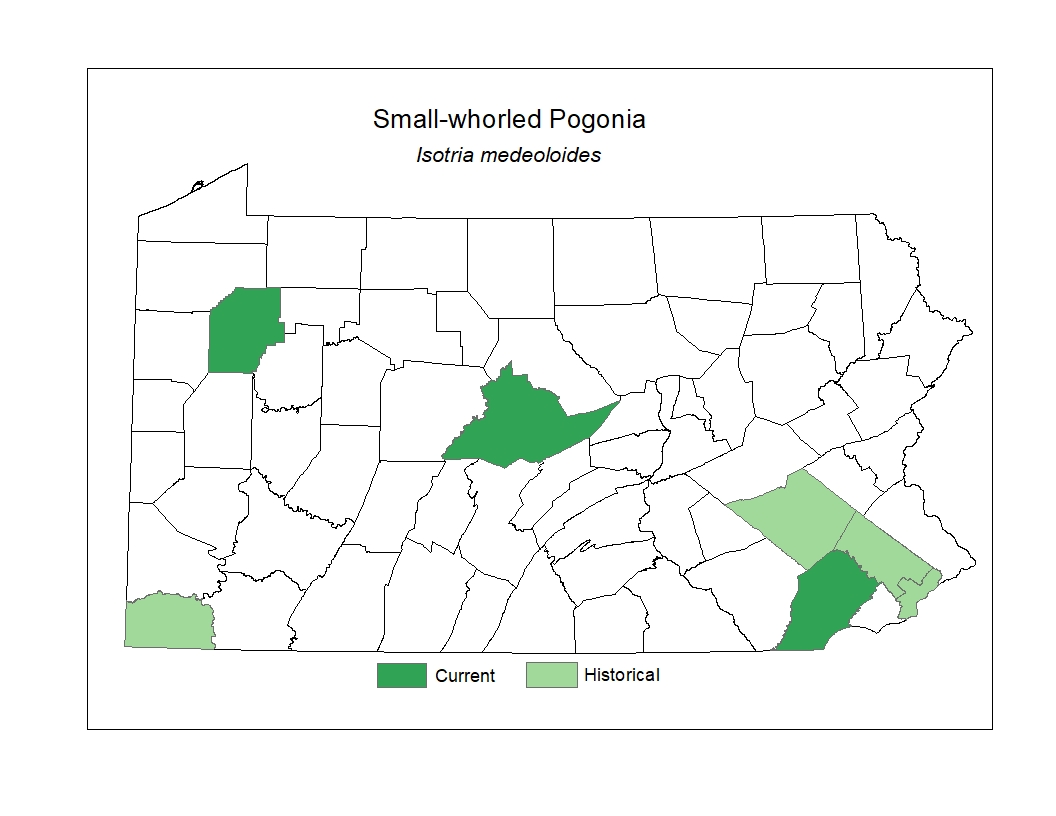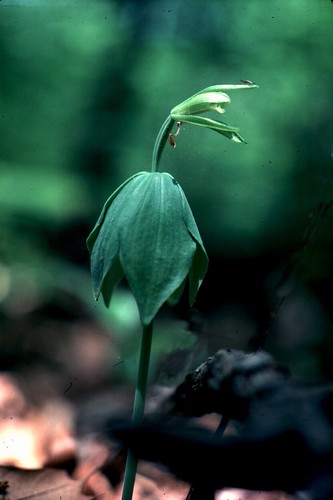 Species Factsheets
Species Factsheets
Isotria medeoloides
Small Whorled-pogonia
State Status: Pennsylvania Endangered (PE)
PBS Status: Pennsylvania Endangered (PE)
Federal Status: LT
Global Rank: G2?
![]() rank interpretation
rank interpretation
State Rank: S1
Did You Know?
The flower of this species lacks nectar guides and fragrance - insect pollination has not been observed so it apears to be a self-pollinator.
Description
Small whoreld-pogonia (Isotria medeoloides) is a delicate orchid with a stout, upright stem 20-25cm high, topped with a whorl of four to six leaves. Single or paired yellowish-green flowers, 2.5cm long, arise from the center of the leaf whorl. This species is most clearly distinguished from the more common l. verticillata (large whorled pogonia) by the shape of the sepals. Sepals in the small whorled pogonia are greenish, not spreading, and are less than a few centimeters long. The large whorled pogonia has widely spreading, purplish sepals, 3.5-6cm long.
Rank Justification
Critically imperiled in the nation or state because of extreme rarity (often 5 or fewer occurrences) or because of some factor(s) such as very steep declines making it especially vulnerable to extirpation from the state.
Habitat
Nearly all small whorled-pogonia populations occur in second growth or relatively mature forests. Pennsylvania populations seem to be most abundant on dry east or southeast facing hillsides in mixed oak forests. The soils are generally rocky and somewhat acidic.
Survey Dates
Flowers late May - June
Distribution

Threats
The small whorled-pogonia is considered our rarest orchid. Only three populatoins are known in Pennsylvania. Data collected by The Nature Conservancy in 1985 shows that approximately fifty-two populations existed from Ontario to South Carolina. The main threats to this endangered orchid are collecting and habitat alteration.
Management
The small whorled-pogonia has been listed as a federal endangered species since 1982. Inventory, monitoring, and protection work initiated by the Western Pa. Conservancy, will be continued through the use of federal endangered species funds. Plants located on public land will be protected by the managing agency.
Conservation Status Map


NatureServe. 2017. NatureServe Explorer: An online encyclopedia of life [web application]. Version 7.1. NatureServe, Arlington, Virginia. Available https://explorer.natureserve.org.
https://www.fws.gov/midwest/endangered/plants/smallwhorledpogoniafs.html
- NatureServe. 2018. NatureServe Explorer: An online encyclopedia of life [web application]. Version 7.1. NatureServe, Arlington, Virginia. Available at https://www.natureserve.org/explorer
- Pennsylvania Natural Heritage Program. 2018.
- Rhoads, A.F. and W.M. Klein, Jr. 1993. The Vascular Flora of Pennsylvania. American Philosophical Society, Philadelphia, Pennsylvania. Rhoads, A.F. and T.A. Block.
- 2007. The Plants of Pennsylvania: An Illustrated Manual. 2nd edition. University of Pennsylvania Press, Philadelphia, Pennsylvania.







